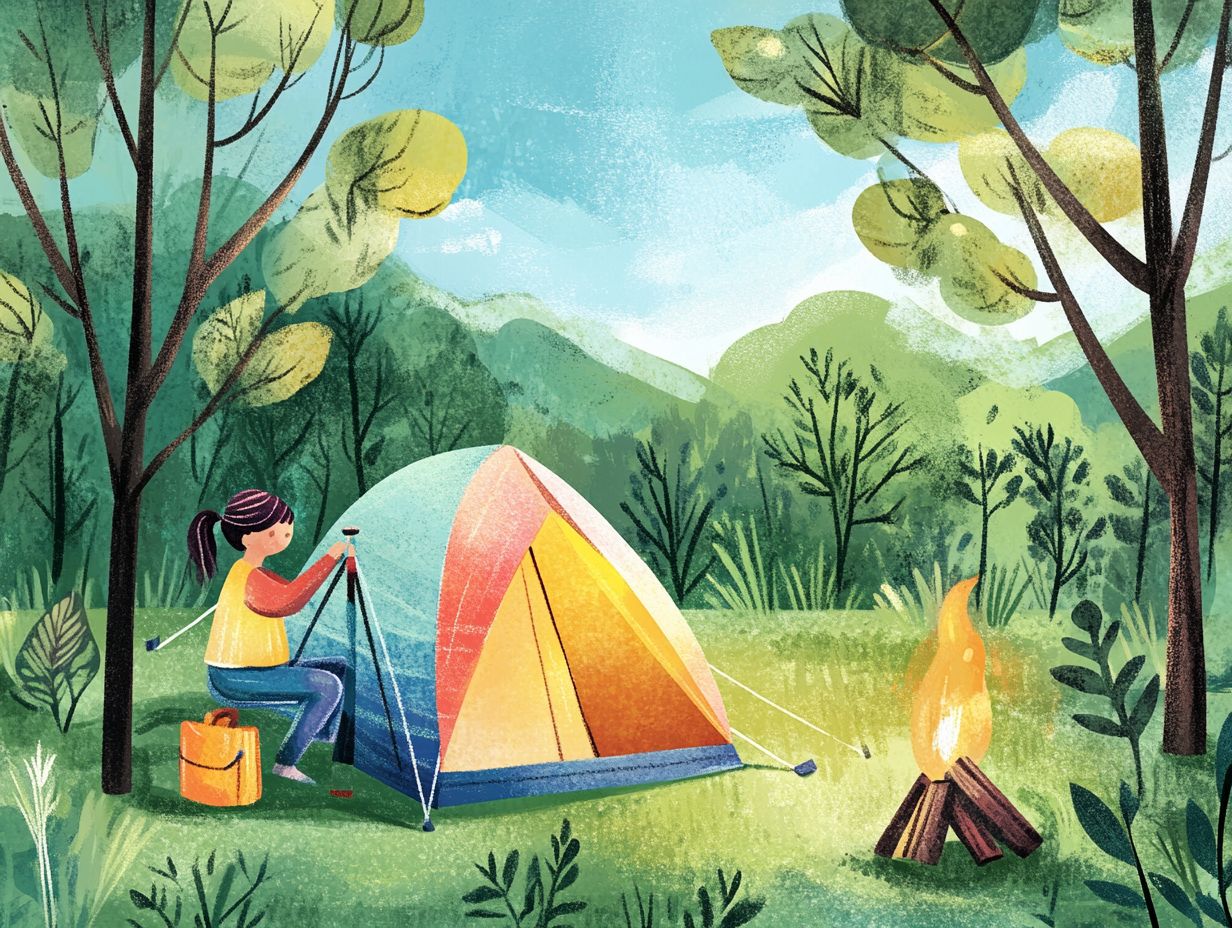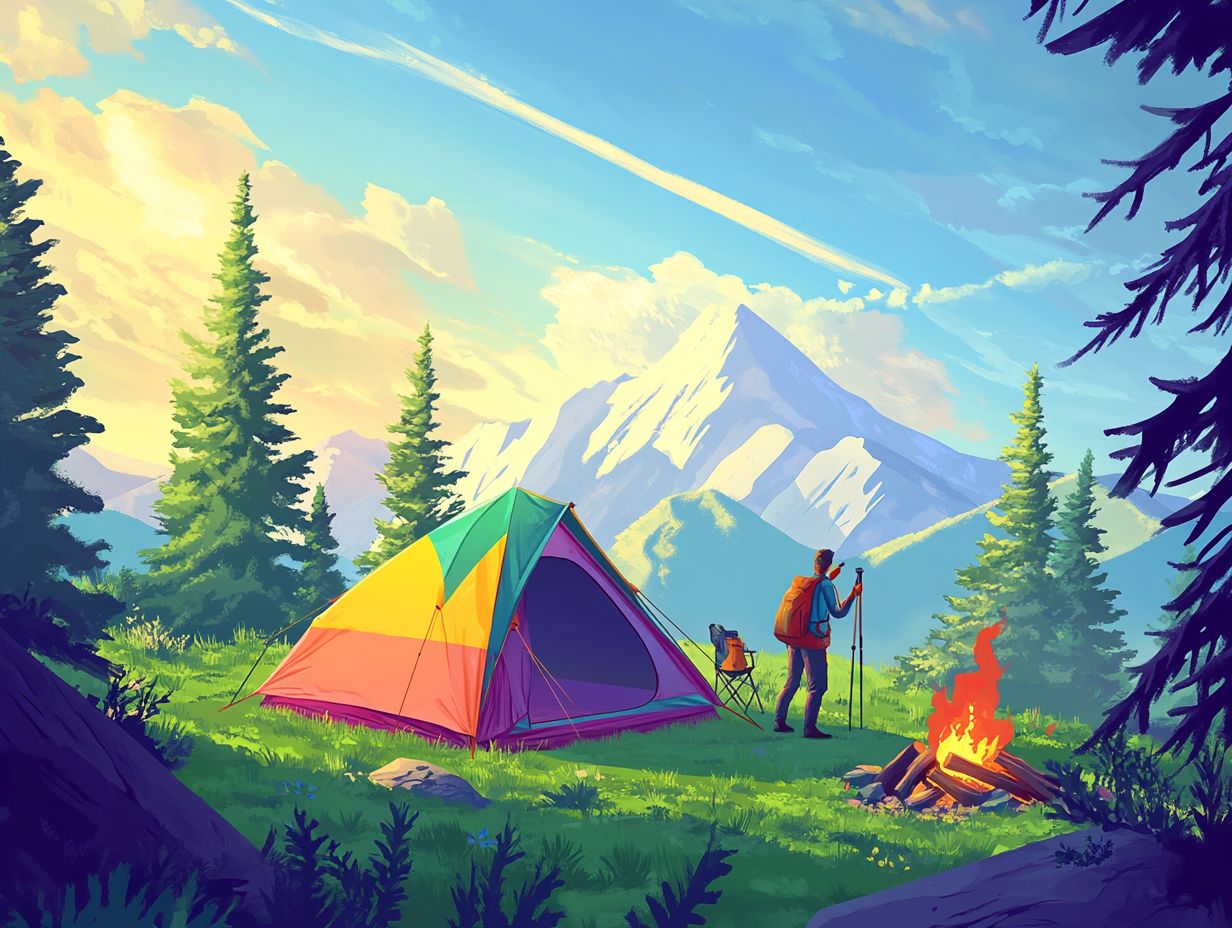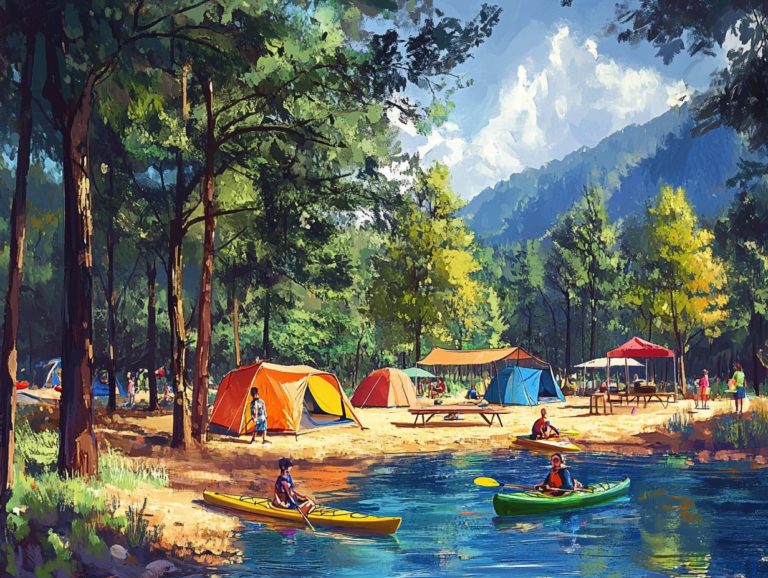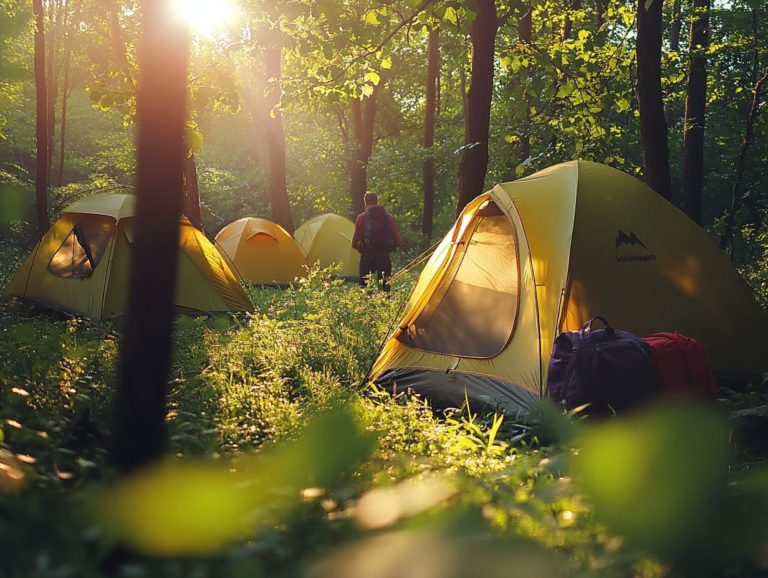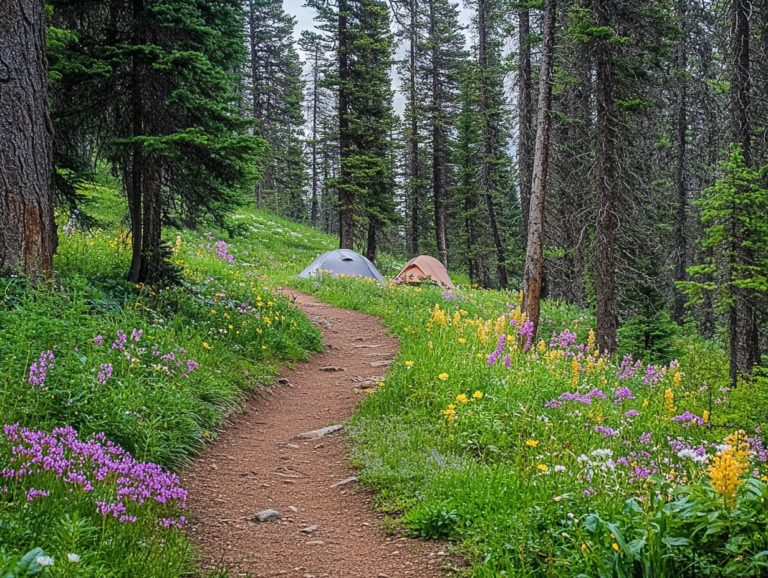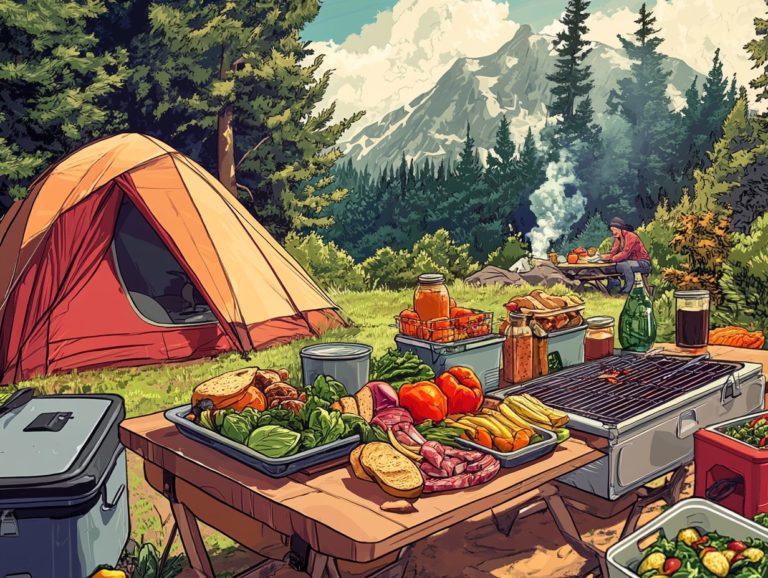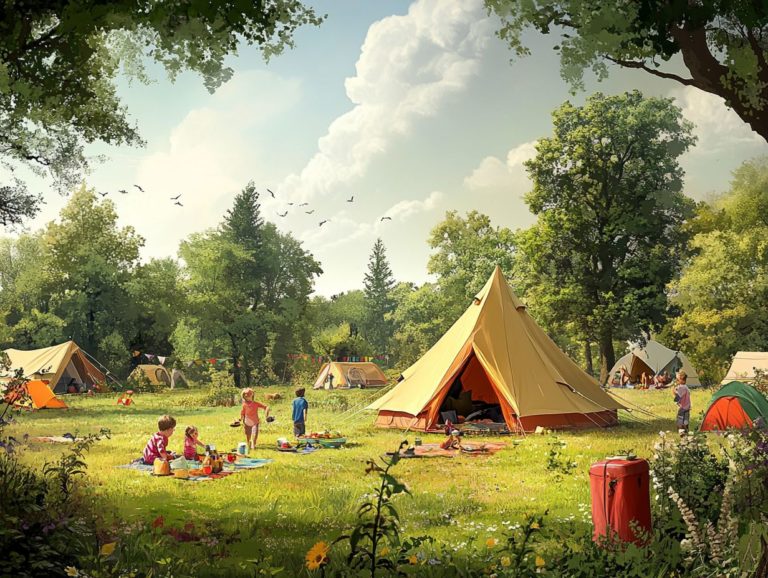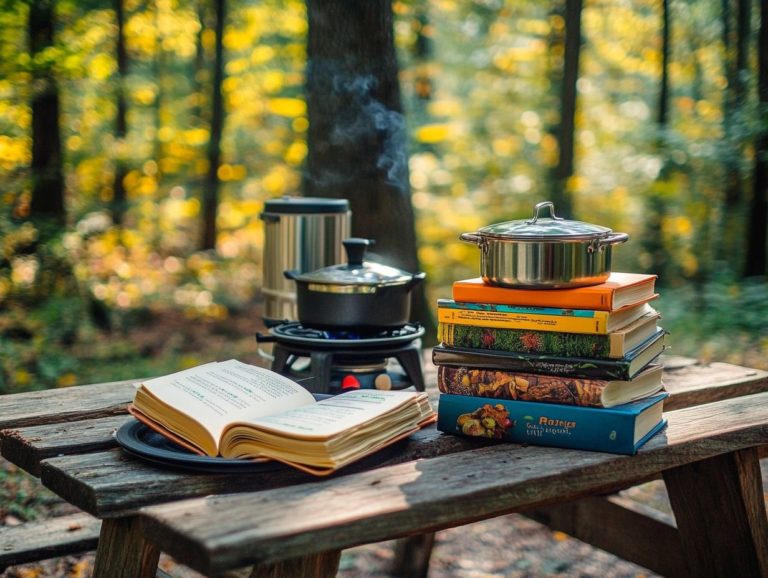Setting Up Camp: A Step-by-Step Guide
Planning a camping trip is undoubtedly an exhilarating adventure, yet it presents its own set of challenges. From selecting the perfect campsite to ensuring you re equipped with all the essential gear, each step plays a vital role in crafting a memorable experience.
This guide will walk you through the intricacies of campsite selection, outline must-have items, provide insights on tent setup, emphasize campfire safety, and suggest enjoyable activities. It also offers valuable tips for cleaning up, ensuring you leave nature as untouched as you found it.
Immerse yourself in this guide and prepare for your most exceptional camping experience yet!
Contents
Key Takeaways:
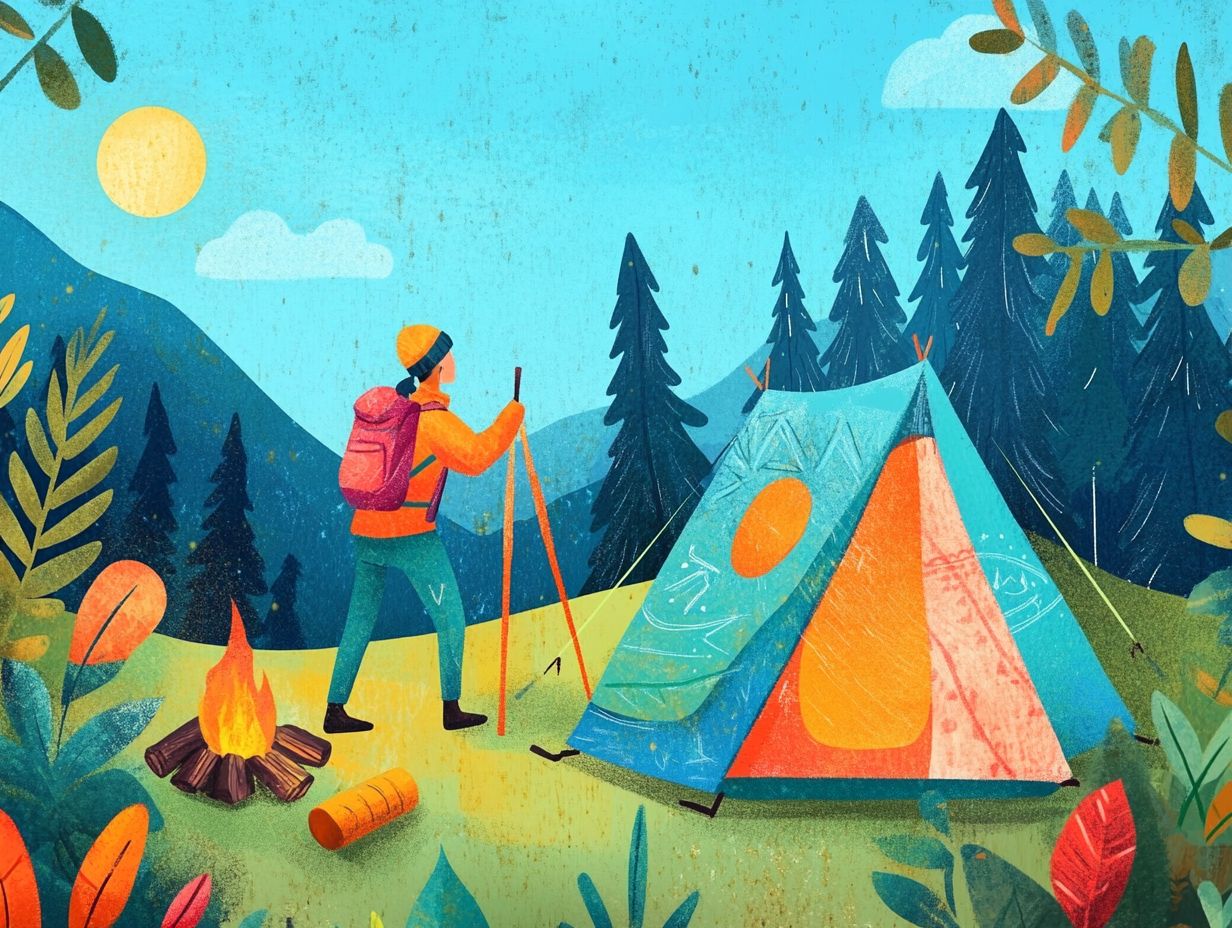
- Choose a campsite that is safe and has access to necessary amenities, such as water and a fire pit. Consider the weather, terrain, and nearby activities when making your decision.
- Don’t forget to pack essential gear like a tent, sleeping bag, and cooking supplies. Also, bring safety and comfort items, such as a first aid kit and bug spray.
- Follow step-by-step instructions when setting up your tent to ensure a sturdy and comfortable shelter. Consider the wind direction and the slope of the ground when choosing your tent placement.
Choosing the Perfect Campsite
When planning a camping trip, selecting the ideal campsite is crucial for both first-timers and seasoned adventurers. Consider factors like accessibility, available amenities, and proximity to popular attractions; these elements can greatly enhance your experience.
Whether you’re leaning toward KOA camping, traditional tent setups, or even glamping options, the right site can set the tone for a successful getaway.
Be sure to take into account the needs of your group. This includes access to water, restroom facilities, and safety from wildlife. These considerations ensure a comfortable and enjoyable adventure in the great outdoors.
Factors to Consider
When choosing a campsite, evaluate various factors that can significantly impact your camping experience. Consider aspects such as campsite accessibility, safety from wildlife, and the amenities available.
You should also think about whether the site can accommodate larger RVs or if it s better suited for those who prefer to pitch tents. Safety measures, like bear-proof lockers (which keep food safe from bears) and designated fire zones (specific areas for campfires), can enhance your peace of mind while enjoying the outdoors.
Amenities such as picnic tables and fire pits elevate your comfort and enjoyment, creating memorable evenings beneath the stars. The proximity to hiking trails adds adventure and lets you explore the breathtaking beauty surrounding you.
Essential Gear for Camping
Equipping yourself with the right camping gear is crucial for ensuring an enjoyable outdoor experience, especially if you’re new to camping and might not know what s essential. A well-crafted camping checklist can be your best friend, helping you gather everything from a reliable first-aid kit and an air mattress for comfort to a camping stove for meal preparation.
The essential gear you need will vary depending on your planned camping adventure whether it s tent camping, RV escapades, or a touch of glamping luxury. Tailoring your packing list to meet these specific needs is vital for a successful trip.
Must-Have Items
To ensure a comfortable and successful camping trip, there are several must-have items you should bring along. Think of a cooler filled with ice to keep your food fresh, a propane camp stove for cooking delicious meals, and a cozy camping chair for unwinding by the fire!
These essentials form the backbone of an enjoyable outdoor experience, especially for first-time campers. A well-packed first-aid kit is crucial for addressing minor injuries. A reliable tent and sleeping bag provide the shelter and warmth you need at night.
You should also consider:
- A multi-tool for various tasks
- Lanterns or headlamps for navigating after sunset
- Appropriate clothing for unpredictable weather changes
Don t forget to bring along a portable water filter to ensure you have safe drinking water. This simple addition enhances your comfort and safety, allowing you to focus on enjoying the great outdoors!
Setting Up Your Tent
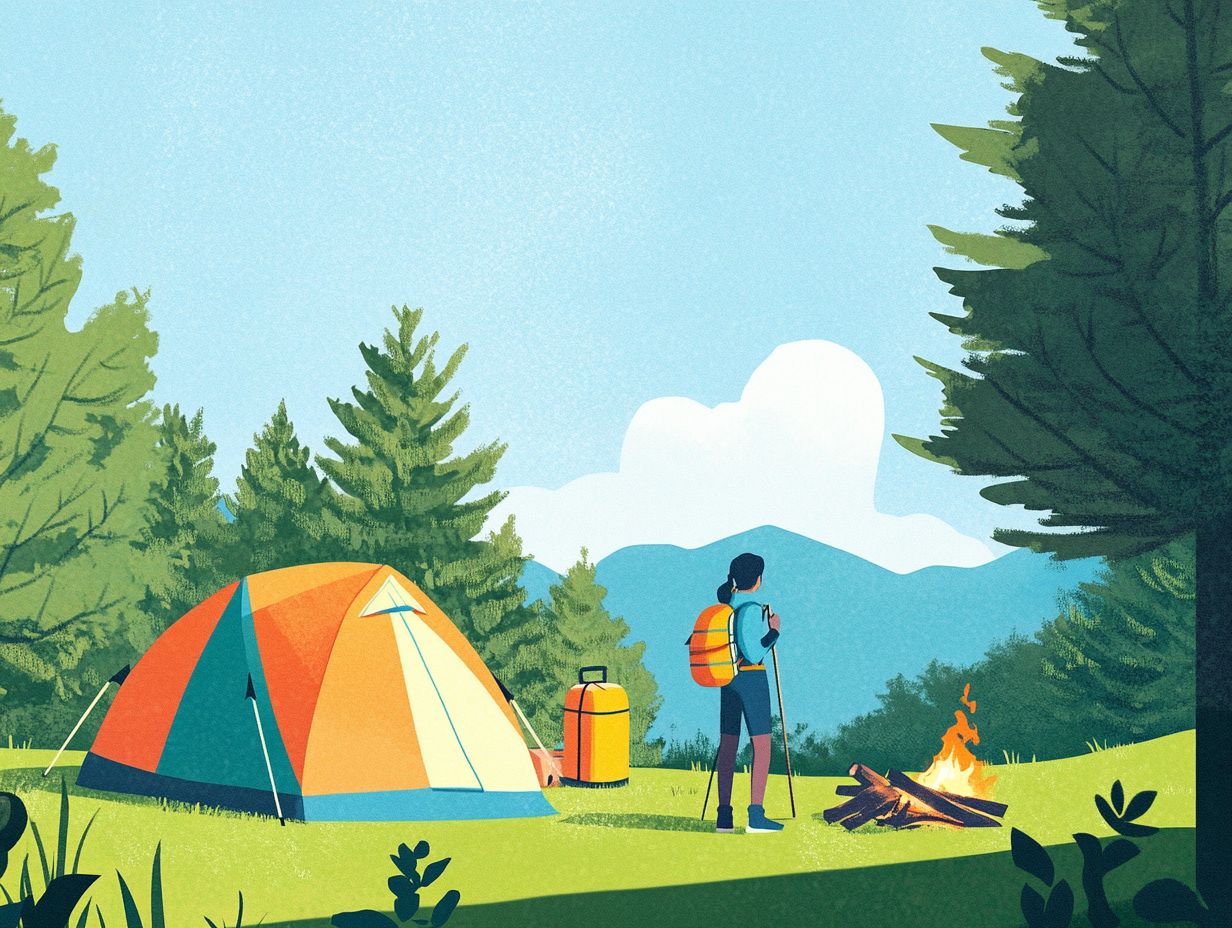
Setting up your tent correctly is essential for a comfortable and secure camping experience, particularly for first-time campers.
Start by choosing a flat, dry spot free from sharp rocks and debris. Lay down a tarp for added protection. As you assemble your tent, extend the poles and secure them with stakes. Ensure your shelter is sturdy enough to withstand the elements and serve as a safe haven throughout your adventure!
Step-by-Step Instructions
Following clear instructions transforms tent assembly into a straightforward experience, allowing you to set up your tent quickly and immerse yourself in the joys of camping.
- Start by selecting a flat, dry area free from debris. This is essential for a comfortable sleep and effective water runoff.
- Unpack the tent components, including the tent body, poles, and stakes. Make sure you have everything.
- Next, lay out the tent footprint, if available. This protects your tent from sharp objects and moisture.
- Assemble the poles carefully, adhering to the manufacturer’s guidelines to avoid breakage.
- Now, attach the tent body to the poles, ensuring all corners are secure and the fabric is taut.
- Drive the stakes into the ground at a 45-degree angle to anchor the tent firmly. This is vital for stability, especially in windy conditions!
By practicing these methods, you enhance the longevity of your tent and contribute to a safer and more enjoyable outdoor experience.
Campfire Safety and Cooking Tips
Campfire safety is essential for a delightful outdoor cooking experience. Improper practices can lead to accidents, particularly for novice campers who may not be familiar with camping etiquette.
Always position your campfire away from tents and flammable materials. Consider using a propane camp stove for meals, as it s a safer cooking alternative. Keep your cooler and ice readily accessible for food safety! Always adhere to local regulations regarding campfires to elevate your overall camping experience.
Precautions and Techniques
Taking precautions while cooking over a campfire is essential for safety and enjoyment.
Familiarize yourself with various fire management techniques. Know how to build a safe fire pit and understand local open flame regulations in your area.
Practicing proper food safety is crucial. Keep raw ingredients separate from cooked meals to prevent mixing raw and cooked food. Ensure your cooking surfaces are clean and use safe storage methods for perishable items. These steps enhance your safety while cooking.
Adhering to camping etiquette, like respecting others’ space and leaving the area clean before you depart, fosters a sense of community and responsibility in nature!
Get your gear ready and enjoy an unforgettable camping adventure!
Activities and Entertainment
A camping trip presents you with an array of enjoyable activities and entertainment options that can elevate your outdoor experience, particularly if you re a first-time camper eager to immerse yourself in nature.
You can explore countless ways to enjoy nature! Whether it s trail running, hiking, or savoring classic campfire delights like s mores, there are endless opportunities to connect with the great outdoors and forge unforgettable memories.
Discovering local wildlife adds an educational aspect to your adventure, transforming your trip into a well-rounded escapade brimming with excitement and discovery.
Fun Things to Do While Camping
While camping, you ll discover a plethora of engaging activities that cater to every interest, from hiking scenic trails and trail running to indulging in the classic delight of s mores around the campfire.
Hiking those picturesque trails allows you to fully immerse yourself in nature’s splendor. It’s an opportunity to observe wildlife, explore diverse ecosystems, and capture breathtaking photographs that will turn heads back home.
If you re looking for a bit more excitement, trail running adds a thrilling twist, merging the joy of jogging with the challenge of navigating rocky paths and steep inclines. It s a vigorous workout that truly brings the great outdoors to life.
Don’t forget the beloved tradition of making s mores. This ritual creates a sense of togetherness among your companions as you gather around the flickering flames, sharing stories and laughter while toasting marshmallows to that perfect golden hue.
These activities not only enhance your physical well-being but also promote mental relaxation, allowing you to create unforgettable memories in the heart of nature.
Cleaning Up and Leaving No Trace
Cleaning up after your camping trip and following Leave No Trace guidelines is vital for preserving our natural environments and ensuring that future generations can relish the beauty of the great outdoors.
Properly disposing of waste, including food scraps and trash, along with observing camping etiquette, are essential steps in maintaining the integrity of your campsite.
Following these principles protects wildlife and keeps nature beautiful, ultimately enhancing your own camping experience.
Proper Disposal and Leave No Trace Principles
Knowing how to dispose of waste properly and follow Leave No Trace principles is key for anyone who wishes to minimize their impact on the great outdoors.
One key aspect of Leave No Trace is properly managing waste, ensuring that nothing you discard detracts from the environment. As a camper, you should:
- Pack out all trash, including biodegradable materials.
- Store food scraps securely to prevent unwelcome wildlife encounters.
When you’re cooking outdoors, utilizing designated cooking areas can significantly reduce the likelihood of leaving waste behind. Exploring composting options for your organic waste can elevate the sustainability of your outdoor adventure while supporting the ecosystem in the process.
Frequently Asked Questions
What are the essential steps to setting up camp?
The essential steps to setting up camp include choosing a suitable location, laying out a groundsheet, setting up the tent, organizing your gear, and creating a campfire area.
How do I choose the perfect campsite?
To choose the perfect campsite, look for a flat and dry area with natural shade and protection from wind. It should also be close to a water source and have a safe distance from any potential hazards.
What should I do before pitching my tent?
Before pitching your tent, clear the ground of any debris or rocks and make sure there are no sharp objects that could damage the tent. It’s also helpful to lay out a groundsheet to protect the bottom of the tent.
How do I set up my tent?
To set up your tent, start by laying it out and staking down the corners. Next, put the poles together and insert them into the corresponding sleeves or clips.
Finally, secure the rainfly. Adjust the tension to ensure a stable, weatherproof shelter.
What essential items should I bring for a successful camping trip?
For a successful camping trip, pack a tent, sleeping bags, pads, cooking gear, and a first aid kit. Don t forget appropriate clothing and footwear for the weather and planned activities.
How do I safely create a campfire area?
To create a safe campfire, first clear a circle of at least 10 feet from anything flammable. Keep a shovel and water nearby to put it out quickly. Never leave the fire unattended! Always check local fire rules before you start.

